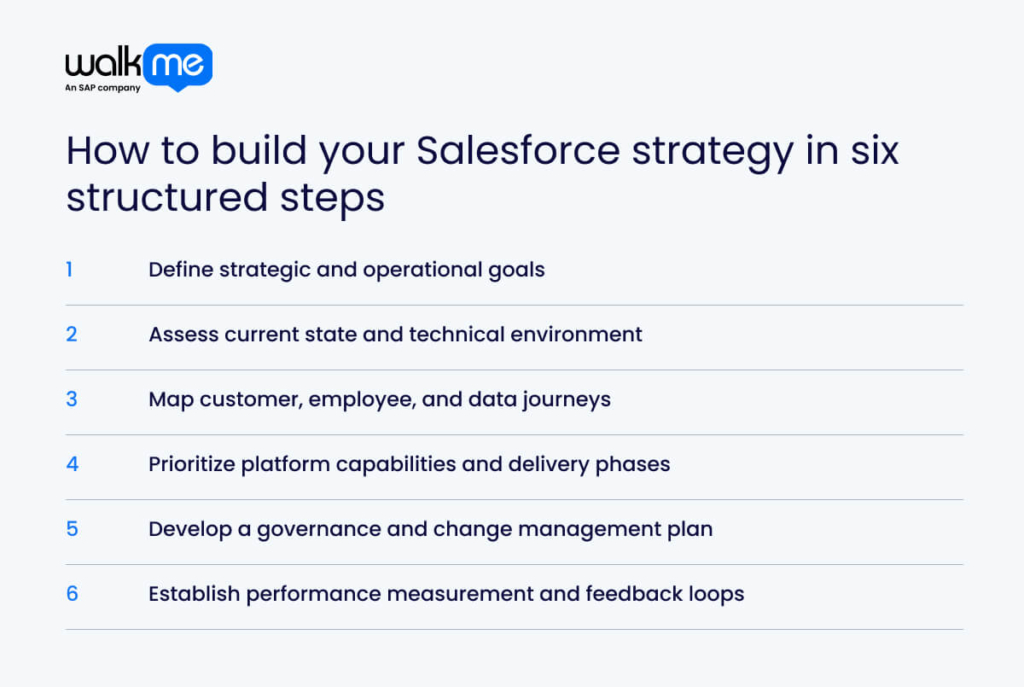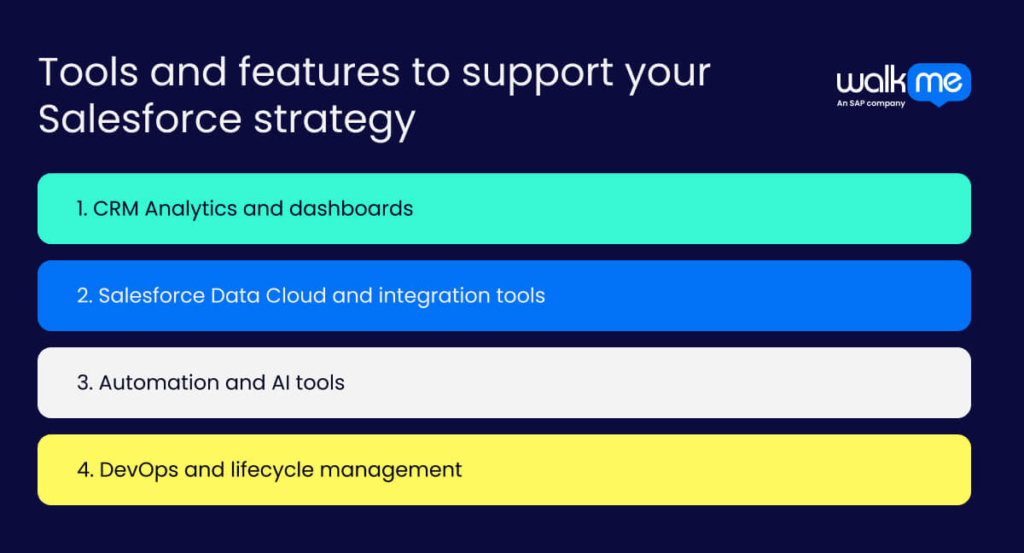Before building a sales team, a leader must define the company’s mission, values, and culture. You need to understand your purpose and how you plan to serve customers.
Once you set that foundation, you can adopt tools like Salesforce to deliver better results. Similarly, a strong Salesforce strategy also focuses on establishing clear goals first. Then, it uses data and technology to improve customer care and drive sales. This plan also helps you leverage your CRM in line with what your customers want.
In this article, we explain what a Salesforce strategy is and how to build one that fits your business. We will also cover Salesforce tools that will be useful during this process.
What is a Salesforce strategy?
A Salesforce strategy is a comprehensive plan outlining how a company utilizes Salesforce to achieve its business objectives. Teams begin by identifying company needs and then select the appropriate Salesforce tools to support areas such as sales, service, and marketing. For instance, a sales-specific Salesforce strategy could include reaching out to new leads through outbound selling or focusing on key accounts with account-based selling.
Additionally, those in customer success may plan to utilize Salesforce CRM analytics to identify trends and enhance performance.
Next, marketing teams could devise a way to generate and nurture leads through multiple channels with a Salesforce strategy. Leaders must remain involved and adjust their plans as business needs evolve. This needs to occur to keep everything aligned and focused on delivering results.
Core components of an effective Salesforce strategy
Understanding the various components of a Salesforce strategy enables businesses to maximize their investment.
When teams understand these components, they can plan, utilize Salesforce effectively, and enhance their results. This leads to improved customer service, a more effective sales process, and increased revenue.
So, these are the components of a strategy you need to be aware of:
Strategic alignment with business objectives
Aligning Salesforce with business goals enables companies to work smarter and achieve targets more efficiently. Teams connect processes, data, and tools to key performance indicators (KPIs) and focus on what drives results.
With a strategic approach, businesses deliver faster and more personalized service. Salesforce automates tasks and streamlines workflows, enabling employees to focus more on high-value work. Leaders can use Salesforce data to identify trends and make informed decisions. This approach enables companies to stay ahead of their competitors.
Additionally, a focused strategy reduces costs by eliminating wasted time and effort. Employees who understand how their work contributes to company goals tend to stay motivated and engaged.
Enterprise architecture and data planning
Enterprise planning strengthens your Salesforce strategy by aligning systems with business goals and supporting future growth. Enterprise architecture (EA) establishes a shared framework that facilitates collaboration among teams across departments. It also identifies and reduces risks, including security issues and compliance gaps.
In addition, data planning treats data as a key asset. It sets clear rules for how teams collect, store, manage, and use data. This improves accuracy, consistency, and reliability. With strong data planning, teams make smarter decisions.
Moreover, it supports Salesforce features like CRM and sales automation. By planning for future needs, teams ensure the data infrastructure scales with growth.
Platform governance and release management
Platform governance and release management keep your Salesforce environment secure and stable. They guide teams in managing updates, making changes, and protecting system integrity. With the right process, teams use resources wisely and deliver better results.
Regularly monitoring the platform helps spot early slowdowns, security risks, and compliance issues. A strong governance process protects data, controls user access, and blocks unauthorized actions. These rules also help your business meet regulatory standards and maintain customer trust.
User enablement and adoption strategy
A structured Salesforce adoption plan helps teams use Salesforce effectively. When companies train users well, they boost productivity, improve customer service, and get more value from their Salesforce investment.
Without a clear plan for employee onboarding, users may miss key features or misuse the system. This can slow progress and waste resources. Companies should offer ongoing employee training and hands-on support to stay on track. These actions allow employees to utilize all Salesforce tools and features fully.
How to build your Salesforce strategy in six structured steps

A Salesforce strategy helps leadership teams unlock the full value of the platform and drive business growth. It lays out a clear plan that aligns Salesforce with company goals and supports smarter, data-driven decisions.
Without strategic direction, teams risk underusing Salesforce and facing costly inefficiencies later on.
Here are the steps you need to ensure better Salesforce use:
- Define strategic and operational goals
Start by setting clear business goals and turning them into specific, measurable Salesforce targets. Link each business goal to a Salesforce feature. For example, you use tools to grow revenue or personalize outreach to improve customer engagement.
Next, define key performance indicators (KPIs) such as sales cycle time, win rates, and customer lifetime value to track progress. Align your Salesforce goals with your overall business strategy by involving key stakeholders.
Then, build a detailed plan with clear tasks, timelines, and resources. Review your strategy often, collect feedback, and adjust your plan as your business evolves.
- Assess current state and technical environment
As your next step, review your current Salesforce setup. Check roles, profiles, and permissions to control access. Review sharing rules and visibility to ensure data protection. Examine security settings and encryption policies. Analyze objects, fields, layouts, and validation rules, and refine data quality.
Remember to review automations, such as flows and workflows, to identify performance issues. Check third-party apps for security risks. Evaluate governance and how integrations affect your system. Measure user adoption and improve training with Trailhead. Lastly, ensure your setup can scale, and consider adopting Salesforce Optimizer to identify and resolve issues.
- Map customer, employee, and data journeys
To map customer, employee, and data journeys in Salesforce, start by setting goals for each. Focus on customer retention, employee engagement, or better data use. Collect insights through surveys, interviews, and analytics. Identify key touchpoints, such as websites, emails, and internal tools.
Then, visually map each journey to show actions, thoughts, and interactions. Analyze the maps to find gaps, bottlenecks, or pain points. Make improvements based on this analysis. Update your processes, training, content, and data flows to ensure optimal performance. Continue to review and refine your journeys to stay aligned with business needs.
- Prioritize platform capabilities and delivery phases
Align your Salesforce priorities with your business goals. Review your current processes and spot areas where Salesforce can improve or replace them. Set clear goals, such as improving sales or improving customer service.
Identify key platform features and categorize them by task type, such as integration or customization. Select features that deliver the most value and require a reasonable amount of effort. Plan delivery in phases, beginning with small wins to build momentum. Keep improving based on user feedback.
- Develop a governance and change management plan
Delivering a good customer experience can be tough, even with a strong Salesforce strategy. Disconnections between data, customer touchpoints, and internal teams often cause problems.
A governance framework fixes this by aligning people, processes, and technology around a shared goal. A cross-functional team typically leads it, breaking down silos and gaining executive support. It focuses on setting clear goals, flexible standards, and best practices.
Additionally, a change management plan helps teams adopt new tools and processes through change impact assessments.
- Establish performance measurement and feedback loops
Track progress using key metrics such as revenue, lead conversion, login frequency, or customer feedback scores. Collect feedback through in-app tools, surveys, meetings, and social media. Analyze the data to spot trends and issues. Then adjust workflows, automate tasks, or update goals to improve results.
In addition, regular employee training keeps users engaged. Hold check-ins with stakeholders and explain changes clearly to ensure the system stays aligned with business goals.
Tools and features to support your Salesforce strategy

Salesforce tools and features play a key role in a strong Salesforce strategy. They help teams boost productivity, engage customers more effectively, and easily manage data. Businesses can utilize these tools to automate tasks, gain valuable customer insights, and enhance teamwork.
These are the tools and features you could find useful:
CRM Analytics and dashboards
CRM Analytics, such as Salesforce CRM Analytics, enables businesses to make data-driven decisions. It improves sales, customer engagement, and forecasting. Teams can identify areas for improvement and personalize customer interactions. This results in optimized operations and lower costs. As a result, you get faster deal closures and increased customer satisfaction.
Salesforce Data Cloud and integration tools
Salesforce Data Cloud integrates data from various sources to create a complete customer profile. It enables personalized customer experiences, data-driven decisions, and automated processes. With AI-powered insights and scalability, Data Cloud breaks down data silos to drive business processes more effectively.
Automation and AI tools
Automation and AI tools in Salesforce enhance a company’s strategy by streamlining processes, providing valuable insights, and improving customer experiences. These tools automate tasks, use AI for predictive analytics, and personalize interactions. For example, Einstein Next Best Action guides sales reps. In addition, Einstein Bots offer instant support, and Agentforce automates tasks.
DevOps and lifecycle management
DevOps and lifecycle management tools can improve a Salesforce strategy by automating tasks. This practice allows faster releases and quicker delivery of features and fixes. Additionally, these tools enhance quality, improve collaboration, and increase agility. DevOps tools strengthen security, ensure compliance, and improve user experience and satisfaction.
Accelerate business resilience through Salesforce strategy
Building a Salesforce strategy marks the beginning, not the end. Review your setup regularly and conduct audits to identify areas that require improvement. Utilize the latest Salesforce updates to keep your platform current. Ask users for feedback often to uncover pain points.
Train your team on new features and best practices so they can use the platform effectively. Set timelines that allow for testing and learning to avoid rushed rollouts. Maintain clean and accurate data to support informed decisions. Promote teamwork by encouraging open feedback. Measure your progress and adjust your strategy to maintain business resilience.
FAQs
A Salesforce strategy outlines the long-term objectives for utilizing Salesforce to enhance the business. A Salesforce implementation plan is a step-by-step guide for setting it up to meet those goals. The strategy looks at the ‘why’ and ‘what,’ while the plan focuses on the ‘how’ and ‘when.’
Salesforce strategies employ various methods to enhance sales, marketing, customer service, and business operations. They help teams get the most out of the Salesforce platform to build better customer relationships, work more efficiently, and grow the business.
A strong Salesforce strategy should cover several vital areas. It must match your business goals, set clear targets and KPIs, and map customer journeys. You should also improve sales processes and set rules for data use. Don’t forget to plan for user adoption, protect data, and use AI and machine learning.

